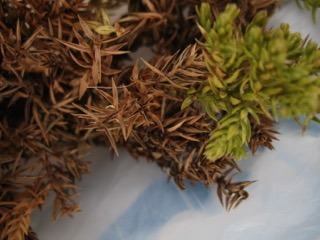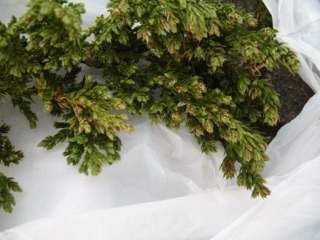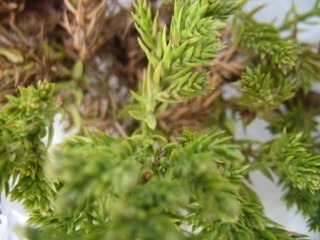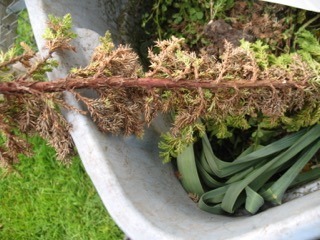Diseased samples of a juniper (see photos below) were brought in to the Jefferson County Master Gardener Plant Clinic for diagnosis. The samples were forwarded to WSU Puyallup Research and Extension Center along with the following description:
12 year old planting of a low growing juniper. The name is unknown .2 years ago it started to die, The owner stated “It got bugs and then they spread.” It now is in about 75% of the planting and on the edge sides of the plants. Nothing has changed : watering, fert, pesticides according to him. He lives on a corner lot and the planting is on bank between the yard to a dirt street. It started on the N/S street and now has moved to the E/W. He built the house, planted on the fill from the cellar hole, said it was a mixture of sand and clay, said there are not drainage problems. All the under branches are dead which could be typical juniper growing in a matlike form. The dieback is mid branch, there is a tiny bit of yellowing on some of the tip branches. The vascular system looks great.
We are stumped. There is not evidence of canker, insect activity or other great sign or symptoms other than the dieback mid branch. I hate to tell him to remove it yet it appears to be dying. He wants a definitive answer.
We wonder:
best possible answer blight and or drought/ soggy soil
could it be cold damage? We have had 2 winters with an extra cold week w/o snow cover ( below freezing into the days) plus 2 wet mild winters.
could it be old age?
Below is the response received:
As for the juniper. I rarely am that satisfied with my answers to juniper questions. I am generally not concerned about older needles/deep in the canopy needle death (attribute much of that to seasonal needle loss http://cru.cahe.wsu.edu/CEPublications/FS056E/FS056E. pdf or poor growing conditions) but if the plant overall looks bad from a distance or tip ends are dying—then I worry about (a) Root rot(b) Twig blight—see response below(c) Adverse environmental conditions (many junipers thrive in dry arid environments so over time the mat-like growth in wet weather coupled with the accumulating layers of plant debris can’t be that good for the species.So I would probably first ask for a landscape shot of the planting, just to see how good or bad the overall planting looks.Here is a common response when we have tip blight symptomology:The juniper problem observed and described is suggestive of Phomopsis twig blight (seehttp://hortsense.cahnrs.wsu.edu/Search/ MainMenuWithFactSheet.aspx? CategoryId=1&SubCatId=3& PlantDefId=18&ProblemId=416 ) but we have rarely ended up recovering this pathogen to confirm the diagnosis, and your sample was no exception. We recommend following Phomopsis twig blight management strategies, however, as it is likely to help the situation. Prune out the dying parts of the plant well below the damage. If possible, try pruning the shrubs for better air circulation. Clean out as much of the fallen needles and other plant debris as possible to improve air circulation. Follow label direction carefully if fungicides are used. Wish I were more helpful.Jenny







